Kenneth A. Camp's Blog, page 24
May 19, 2015
Foster Care through the Eyes of a Court Appointed Special Advocate (CASA)
The Many Faces of Foster Care—An Interview with Everett Carmody, President of the Board of Directors of Travis County CASA
Everett Carmody is the current president of the board for the Travis County (Texas) Court Appointed Special Advocate (CASA) organization (www.casatravis.org). Counties across the country have CASA volunteer organizations some more successful than others. Here in central Texas we are blessed with some of the best in the nation. These volunteers play a very important role in the lives of foster children. Please take a moment to read this interview and learn about CASA. You just might decide this is how you want to invest in the life of an at-risk child.
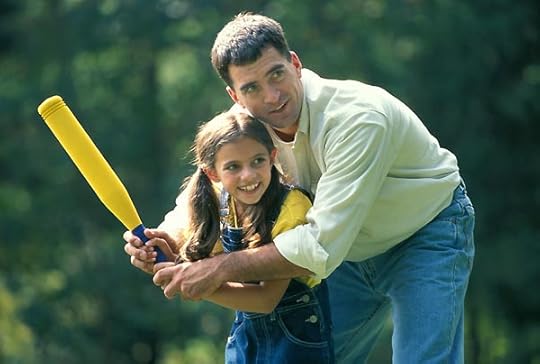
Photo Credit: Gerard Fritz via Compfight cc
What is a CASA volunteer?
A CASA volunteer is a trained community member who is appointed by a judge to represent the best interest of a child or family of children in the court system. Volunteers spend an average of 15-20 hours a month advocating for these children for at least a year. They get to know the child while also gathering information from the child’s family, teachers, doctors, care-givers and anyone else involved in the child’s life.
CASA volunteers serve as the guardian ad litem, an official representative in a Child Protective Services (CPS) case entitled to access information about the child’s situation and required to make reports to the court in the child’s best interest. CASA volunteers speak for what is in the child’s best interest while the attorney ad litem speaks on behalf of the child’s wants or preferences – often these two opinions differ with serious potential consequences. (from CASA of Travis County FAQs)
What does CASA do?
CASA of Travis County believes every child who’s been abused or neglected deserves to have a dedicated advocate speaking up for their best interest in court, at school and in our community. To accomplish this, CASA educates and empowers diverse community volunteers who ensure each child’s needs remain a priority in an over-burdened child welfare system. (from CASA of Travis County FAQs)
Have you served as a CASA volunteer?
Yes, I have served as a CASA volunteer. The first case I was assigned to involved four little sibling boys ages six, four, two, and five months. All of the children were already in the child welfare system and had been taken away from their mother and everything familiar to them. Confidentiality prevents me from getting into more specifics, but I am very pleased to tell you that all of the boys have been adopted by terrific families and are doing well. These boys now have a bright future.
Why did you become a CASA volunteer?
I had participated in various CASA fundraising activities over several years and at one of these events a former foster child, now an adult, spoke about how important and impactful his CASA had been in his early years in the child welfare system. I followed up with CASA, and they were terrific at explaining how a CASA gets to help change the direction of a young child’s life. I was hooked to learn more.
What are some challenges and reward of being a CASA?
In my particular case, the rewards were many but what brings me the most joy is the fact that I got to help break the generational cycle of a family for who it was somewhat normal to have their kids in the child welfare system. Also, I got to experience the tearful joy of seeing the boys stand up in court and tell the judge that they wanted to be adopted by their forever family.
With respect to challenges, it’s none other than getting fully up to speed on the history and background of the case and meeting all of the various parties involved. The judges, lawyers, CPS workers, teachers, counselors, medical professionals, etc. are very accepting of CASA that this does not take much time.
What difference does CASA make for children recovering from abuse or neglect?
Children with CASA volunteers are more likely to end up with family. Of the 641 children’s cases closed with the help of CASA last year, 52% were reunified with their parents and 22% were adopted by or live permanently with relatives.
A study by Texas Appleseed, “Improving the Lives of Children in Long-term Foster Care,” reports that “If a child has a CASA, the CASA usually is the only person who truly knows the child and knows how the child is really doing.”
National CASA reports that children with CASA volunteers are more likely to receive therapy, health care and education, more likely to do better in school, less likely to be bounced from one place to another, less likely to get stuck in long-term foster care and significantly more likely to reach safe, permanent homes.
A CASA volunteer is often the child’s only link to maintaining family connections and can be instrumental in identifying family members as temporary or permanent placement options.
Most importantly, children themselves report that they know and can rely on their CASA volunteers.
(from CASA of Travis County FAQs)
How does someone become a CASA volunteer?
Volunteers complete a screening interview, background and reference checks, and 39 hours of intensive training and courtroom observation. After being sworn-in by a judge, volunteers are appointed to a child or family of children and spend an average of 15-20 hours a month advocating for these children for at least a year. Prospective volunteers must be at least 21 years of age, and must pass extensive reference, Child Protective Services, sex offender registry and criminal background checks. (from CASA of Travis County FAQs)
Ready to advocate for a child who needs you?
To find a CASA organization in your area go to CasaforChildren.org.
May 15, 2015
Understanding How Transitions Affect my Son
3 Types of Transitions
My adopted son just completed his second year of preschool. A few weeks ago some coping behavior resurfaced—chewing on his shirt, separation anxiety, etc. Danielle and I struggled to find the cause. Then on the way to his next to last day of school, he asked Danielle, “What if my teacher next year doesn’t love me?”

Photo Credit: TheaBredie via Compfight cc
We then understood that this was most likely the cause of his behavior. I knew most kids ramp up at the end of the school year and wonder what the next year will bring. But this took me a little by surprise.
Honestly, I was frustrated by his regressed behavior especially his separation anxiety. I had to breathe deeply when he clung to my leg instead of going into his classroom or when he didn’t want me to leave the house. Part of the frustration was me not understanding the cause. I really shouldn’t need to always understand the cause. I know sometimes I never will understand. But it helps.
His question revealed his heart to me. Which in turn reminded me he needs patience and gentleness from me. Knowing his fear helps me to at least try to discuss it and help ease it. He and I can talk about it, process it, and deal with it in a constructive way rather than him suffering and coping on his own.
We know now how much chronic trauma affects the wiring of the brain and the result is chronic fear. Any child will struggle with transitions; however, if they feel safe and feel that their environment is predictable, then that child probably will handle transitions better.
The reminder for me is that my son who did have chronic trauma at an early age needs me to help create as safe and predictable an environment as possible to help ensure smooth transitions.
There are three main types of transitions:
Daily transitions – Moving from one activity to another throughout the day challenge a child who is fear-driven or in survival mode. A daily question, sometimes many times a day, that our son asks is, “what are we doing tomorrow?”. If I don’t plan well for these transitions—provide adequate warning; build in extra time; stay patient—I create a stressful environment for my son which makes it more difficult for him to self-regulate.
Major life transitions – This is the one that we think has caused his latest behavior—the end of the school year. In my adult brain, it’s not that big of a deal. But to my four-year-old son who has abandonment issues, it’s huge! The last thing I need to do is berate his behavior, tell him to not worry about it, and move on. Instead taking time to process the transition by letting him tell his story, drawing a picture that tells the story, etc. will help his brain reorganize around this bit of information and make sense of the transition.
Developmental transitions – We all have to learn how to navigate developmental transitions. In my 50s, my brain is reorganizing around the fact my body doesn’t recover as quickly as it did when I was in my 30s. For a young child these transitions come more often as they age. Our son is no longer an infant, but now a preschooler quickly becoming a young child. Children need predictability and some level of control. A child especially from a trauma background benefits from family or daily rituals, such as, getting up at the same time, eating meals around the same time, and having a similar nighttime process.
Even though I have read many books on trauma and how it affects transitions in life, I needed this reminder. I easily slip into a default mode of reacting to the behavior instead of proactively preparing for each type of transition.
May 12, 2015
Foster Care through the Eyes of One Who Aged Out of the System
The Many Faces of Foster Care—Bruce Moore's Story
Imagine your mother dropping you off at a children’s home at age three or four along with your younger brother. Then spending the rest of your growing up years moving from one foster home to another, wondering if you and your brother will stay together, learning that you really do have a mom and another brother when you are about age eight, then at age 18 meet two sisters for the first time. How would you make sense of it? What are the odds you would do well in school, much less in life?
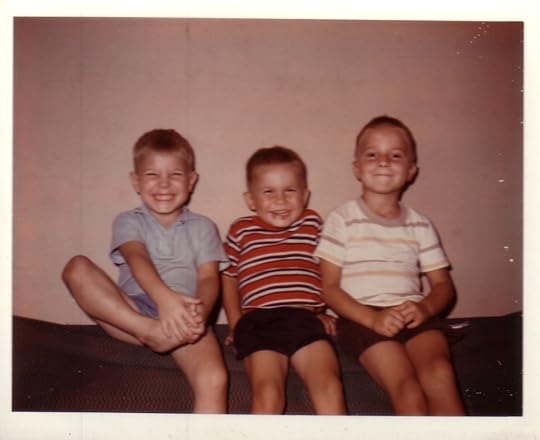
Bruce (far right) with his brothers
That pretty much was Bruce Moore’s life. Bruce lived his entire life as a foster kid which means he was in the custody of the state. No one ever adopted him even though he lived with the third foster family for over 15 years. He found out around age 17 that his biological mother never relinquished her parental rights, and it seems that the state didn’t have a reason to terminate them.
Bruce legally “aged out” of the system when he turned 18. He beat the odds though, because most foster kids who age out of the system face a lifetime of unemployment, broken relationships, and addictions. Yet, Bruce, who is in his early 50s, is still married to his bride. They have three grown children, and they own their own business. What made the difference for Bruce?
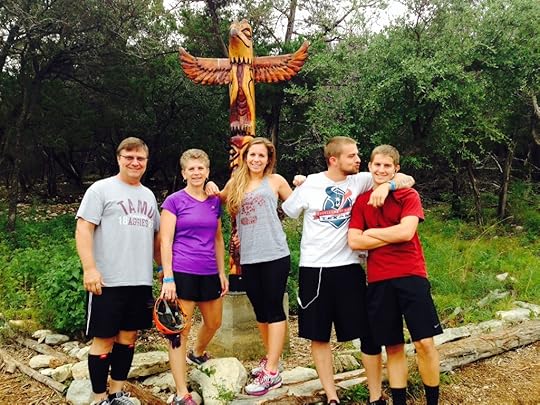
Bruce with wife Angie and their three children.
I am honored to share some of Bruce’s story of growing up as a foster child. As you read his story, look for the answer to that question—what made the difference for him? You might just be able to make a difference in a child’s life too.
Bruce Moore’s Story
Foster Placements
Bruce’s mother dropped him and his brother off at a children’s home when he was about 3-4 years-old. From then until he was about 11 years-old, Bruce lived in four homes. Soon after being left at the children’s home, the state placed Bruce and his brother in a foster family’s home. This family had a son who was younger than Bruce but older than his brother. After a couple of years, they decided that they wanted their biological son to be the oldest, so they wanted to send Bruce back to the children’s home but keep his brother. The state decided to keep the brothers together.
The state moved the boys to foster family #2. A couple in their 80s who had fostered many children. This couple had received recognition for their service. However, Bruce’s memory as an elementary age boy was the long list of chores he had—clean house, wash clothes, tend to chickens and rabbits, keep the garden, maintain the yard—and take care of “papa” when he messed himself in bed.
No doubt this foster family provided a needed home for many children throughout the years, but by most standards, this was not the best environment for Bruce and his brother. Discipline bordering on abuse, neglect, inappropriate physical labor…still Bruce’s comment, “I didn’t know any different. That was life.”
Because of this couple’s age, the state decided again to move Bruce and his brother once again to another foster family. Foster family #3 and the boys fourth place to live.
A couple in their 50s began to visit the boys. Bruce is 11 years-old by now. He feels a slight connection and comfort with this couple. They went out of their way to help Bruce and his brother feel safe, even opening up a telephone book on their first visit to show the boys that indeed they were real people with a home and phone number.
Bruce and his brother did end up moving to this foster family. And, Bruce lived with this family until he married at age 27. However, the family decided to place his younger brother, when he was about 14, back at the children’s home because of behavioral challenges. The brothers were split up after all.
Challenges
Growing up as Bruce did creates challenges. These challenges aren’t unique to Bruce. Any child in foster care faces these and many more.
Trust
His first foster family sent him back to the children’s home. His second foster family basically treated him like he was child labor. No wonder by the time he moved to his third foster family, he didn’t trust them or anyone else. He, like most any other foster kid, learned how to survive. He soon figured out that “you can send a foster kid back”. He did his best to stay out of trouble, so he wouldn’t be sent away.
Education
No one read to Bruce or his brother when they were young. Bruce didn’t attend kindergarten, so when he began 1st grade, he didn’t know how to read. He never recovered. With no one advocating for his education, and the state diagnosing him as mentally retarded, little was expected of him.
When he moved in with his third foster family, he was in the fourth grade but reading at a first grade level. The school placed him in special education, later called resource, where he remained until he graduated from high school.
Struggling in school is common for foster kids, especially those who move a lot. Think about it. How can a child concentrate on learning when they are constantly in “survival mode”?
Shame
Shame runs rampant within foster kids minds. What did I do wrong? What is wrong with me? Why doesn’t my real mom or dad want me? Shame and regret also haunts biological parents who aren’t able or willing to take care of their children. The shame entangles the family like a weighted fishing net pulling them deeper into the abyss.
As Bruce began to understand that he was called a foster kid, his friends would ask him, “what’s a foster kid?” “Did you do something wrong, rob a bank, or kill somebody?” “No, I don’t think so”, Bruce would reply. But really he didn’t know why he was a foster kid.
Making Sense of Life
He remembers never talking to his friends in school about parents. It wasn’t a part of his vocabulary. He never wondered what another friend’s dad or mom did. Why would he? Recently Bruce had the thought, “I’ve never called anybody dad.”
Bruce never meant to disrespect any of his foster parents, but especially after he found out he had a real mom, he would never call any of them “mom” or “dad”. After his mom came back into the picture, like most kids in foster care, he kept believing that she was going to remarry, get back on her feet and come get Bruce and his brother so they could be a family again.
But that never happened.
As Bruce learned more about his biological family, he comes to the defense of his mom and other parents whose children are in foster care. As he puts it, “no one knows their story.”
What helped Bruce “succeed” where so many others fail?
Mentors! As I listened to Bruce tell his story, I heard him mention over and over different people who invested in him. Some for many years like the last foster family. Those foster parents spent time with him playing sports, helping with school work, providing stability.
Bruce related stories of school teachers, Sunday school teachers, coaches, even older foster brothers who all encouraged, mentored, and helped Bruce along the way.
For example, Bruce told me a story about one man from his church who spent some time with him one day when Bruce was a teenager. His whole purpose was to teach Bruce about how to treat women, and the need to be wise in his relationships. This man didn’t have to do that. But it was a thing a father would do.
My Thoughts
I believe mentors and father or mother figures gave Bruce the foundation for success.
No kid asks to grow up in the foster care system.
Every child from a hard place needs others to tell them over and over that they have value.
If I could do it all over again, I would tell someone to adopt me. Bruce Moore
In the community where you live are boys and girls just like Bruce. Children who for no reason of their own are in this kind of situation. Would you consider how you can at the very least be a mentor, if not making them a part of your family either through adoption or fostering?
May 8, 2015
Foster Care through the Eyes of a CPS Employee
The Many Faces of Foster Care—Interview with Jennifer Burns
We fostered our son for 15 months before we adopted him. During that time, I interacted with several different employees of the Child Protective Services (CPS). Home visits. Parent visits. Family meetings. Court appearances. I now think that they have one of the most challenging jobs around.

Jennifer Burns, Adoption Supervisor with DFPS
Even though it’s the objective of the department to help families and children, they often are viewed as the “enemy”; not only by biological families but also by foster families.
Burn out and turnover is high. Caseworkers are overloaded and underpaid. Yet, most do their jobs well with passion and compassion for struggling families and children.
I knew of Jennifer Burns through a good friend who adopted a son from foster care. Then we met Jennifer when we signed the adoptive papers for our son. I asked Jennifer for this interview, because I think it is important that we at least get a glimpse of foster care through the eyes of a CPS employee. The best way to care for struggling families and children isn’t antagonistic relationships, but instead ones of collaboration.
I invite you to read this interview with Jennifer Burns, Adoption Supervisor with CPS to see foster care through her eyes:
How long have you worked with CPS?
I have been with the Department for over 8 years. I started in February 2007, right after I graduated college.
What roles/positions have you had within CPS?
When I started in 2007, I was in the conservatorship unit. I worked there for 3 years. In February 2010, I transferred to the adoption unit as an adoption preparation worker. In September 2013, I was offered the job as Adoption supervisor and I have been there ever since
What compelled you to work with CPS?
Growing up I never knew CPS existed. It wasn’t until college when I was studying elementary education and the professor was talking about CPS and it got my attention. I felt I needed to fight for children since they are unable to do so themselves.
What is the role of CPS in regards to children and families?
We get involved with families and children’s lives to help them. We offer a number of different services to help them better parent their children. We educate them. We also help with substance abuse and drug abuse. Several rehabilitation programs exist across the state, and we have the resources to help families access them. We hope that with our intervention, that we can reunite families. That is always our main goal if it is in the children’s best interest.
What challenges do you face now or in the past?
I think one of the hardest things is to keep your emotions out of it. It is human nature to have an emotional reaction to different situations, and as a CPS worker it is best to stay strong and not show your reaction. There were many times when I cried after hours because parents didn’t have their children during the holidays or on their birthdays because they were in rehab battling addiction, or a teenager was at a treatment center stabilizing his behaviors because his parents gave him to the state because they could not handle it. And as a parent, those can be tough to see. Those struggles never go away, you just learn to cope with them and take it a day at a time.
What do you find rewarding about working with CPS?
When I started back in 2007 in Conservatorship, it was rewarding to see the children return home to their families after services were completed and lives were changed. To see a drug addict, overcome their addiction and get their children back in their home.
In adoptions, we have youth from all ages, races, genders who are free for adoption. While I love every adoption that occurs, it is very special to see a teenage youth, who has been in several different placements, who has behavior issues, finally find their forever family.
“
I believe there is a family for every child, it is our job to find that family.
—JENNIFER BURNS

What do you want the general public to know about CPS?
I want people to know that we need foster parents. The system is full of foster youth that bounce from placement to placement and we need you to help provide them a short-term or even long-term home.
I want people to know that it is easy to adopt a youth and there are lots of children who need a forever family. These foster children did not ask to grow up in our system. If you want more information about becoming a foster or foster/adopt parent, please call me 512-864-6008.
How should you respond to the call set forth by Jennifer?
Even though not everyone is called to foster or adopt, many of you would if you understood the need and what is involved. However, if you don’t feel called to foster or adopt, contact me to find out other ways you can support those in the foster care system.
May 5, 2015
How to Live in Community without Getting Hurt
5 Reasons We Find it Hard to Live in Community
Living in community is a lost way of life. We are aware that we don’t even know our neighbors much less live in community with them. And I understand why. It is a pain.

Photo Credit: safrinanoor via Compfight cc
During the generation when families moved from rural farming communities into more urban settings, they brought with them a sense of community. They built houses with big front porches. They helped each other with projects, sick kids, errands…anyway they could. That was the “neighborly” thing to do.
But somewhere over time that way of life has all but disappeared. Sure pockets of it exist. But now people build their houses so that they live life in their backyards behind their privacy fences after they have pulled their cars into their garages opened and closed by automatic door openers. The only act of being “neighborly” is the head nod at “what’s his name again?”
Church isn’t much better. We attend one or two meetings a week shaking a few hands, catching up on trivial matters, then rush off to eat lunch or attend a ballgame.
Why has life become like this? Why do we find it hard to live in community?
It is exhausting.
I can’t always do what I want.
I don’t like rejection or getting hurt.
We have to care for each other.
I don’t want people to really know me.
Here is a microcosm of the challenges of living life together: when a group of people go on a short-term mission trip for a week or two. Talk about living in community. Especially if the team travels a far distance. Team members eat their meals together, share living space, learn each others idiosyncracies, etc. What begins as an exciting adventure can quickly break down to learning how to survive each other.
Ok, so living in community is hard. We get that. All these challenges are true. But we overlook something plain and simple. If we don’t put in the effort to live life together as Christians, then we miss opportunity after opportunity to reflect the gospel—how will they know we love each other if they don’t see us live life together. It’s easy to attend those one or two church gatherings a week and be on our best behavior, hiding behind our facade.
So that is why we should live in community as a Christian, but seriously how do we do that without getting hurt, rejected, exhausted, etc.?
We can’t do it on our own that’s for sure. Well, I sure can’t. Still, we try to do it in our own power and strength. No wonder it hurts.
Instead, if we walk with the Holy Spirit, His fruit overcomes exhaustion, selfishness, lack of compassion, etc. This is how they will know God is in us. Really, the title is misleading. We still probably will get hurt, rejected and so on if we truly live life with others. But again, it is through those painful life experiences that God’s Spirit reveals His nature, if we let Him.
The fruit of the Spirit is love, joy, peace, patience, kindness, goodness, faithfulness, gentleness, and self-control Galatians 5:22,23
May 1, 2015
The Dirty Little Secret that Is Keeping You from Connecting with Your Child
I admit it. I am addicted to my devices. I obsessively pick up my smart phone anytime I have downtime. Sadly, I even will do this when I am with my son. For example when we are at a fast food restaurant, or when he is bathing, or I am “playing” with him in his playroom, within a few minutes I pull out my phone. There, I said it.

Photo Credit: bill.sarris via Compfight cc
I know I am not alone. It’s an epidemic really. People hardly look where they are going anymore because they are looking at their mobile device while they are walking, riding a bicycle, even driving a vehicle.
My wife and I went to a movie not too long ago. After the movie, we made our obligatory trek to the bathroom. We looked down the hall and both laughed out loud. Two men stood on opposite sides of the hall obviously waiting for their spouses. Both had the same pose leaning against the wall staring at their smartphones seemingly unaware of the other. I would have felt as if I were interrupting if I needed their attention.
I know that is how my four-year-old son feels when I pay more attention to my mobile device than I do him. Sometimes he physically lifts my face up so I will look him in the eyes. Ouch!
As parents of an adopted son, we have learned a lot about attachment and connection. It doesn’t take a brain surgeon to realize that this mobile device addiction that many of us struggle with isn’t good for forming healthy attachment and connection with our children, biological or adopted.
Studies on how our usage of mobile devices impacts our relationships, not only with our children but everyone, are just now being done, like this one—Patterns of Mobile Device Use by Caregivers and Children During Meals at Fast-Food Restaurants.
This good article—Mom, Put Down Your iPhone and Pay Attention to Me—expounds well on the study.
I think you know what the Dirty Little Secret Is that Is Keeping You from Connecting with Your Child is, don’t you?
With some encouragement from my wife I decided on a month-long media fast. After work when I was home with my family, I turned off my cell phone (now you know why I didn’t respond to you within 3 seconds). I didn’t watch any TV, except the NCAA men’s basketball Final Four and one Spurs playoff game. I closed my laptop at the end of the day except on a few occasions to do a bit of work or research, but I avoided mindless internet or email time.
That time became a Screen Free Zone.
What do you think were the results? Yep. I am sure you could list a few. I spent more engaged time with my son and wife. We actually looked at each other while we talked to each other. I can tell my son feels more connected to me. He said on more than one occasion to my wife that he was looking forward to spending time with me.
I don’t think everyone needs to do a media fast, but at least for me, it’s what I needed to disconnect from the technology. Now that the month is over, I plan on continuing some of the new habits:
Leave my phone off and on my desk after work when I am home with my family.
Leave email alone after work until the next day.
Be more selective about what I watch on TV.
Before my son’s bedtime, spend time with him, fully engaged.
After he goes to bed, do things that don’t involve a mobile device like spend time with my wife, read (even though I do read on a Kindle), or work on a project around the house.
I know I need to take control of the amount of time and when I use mobile devices and technology, or it will control me. I want connection with my family and friends—real connection—one that happens when one looks into the eyes of another and knows each is fully present, fully engaged.
April 28, 2015
Who Are the Many Faces of Foster Care?
I know numbers can make our eyes glaze over. Especially when we discuss them in the thousands. The numbers overwhelm. We respond with a slow shaking of our heads and think that something ought to be done about it. But, soon we return to our own problems; ones that touch us closer. That is, until something grabs our attention. Or it involves someone close to us, maybe from our own family. Or, we hear a true story of a child that puts a name and face to one of those 250 thousand. Then we care.
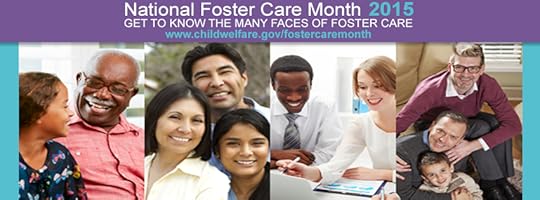
May Is National Foster Care Month
In 1988, President Reagan issued the first presidential proclamation that established May as National Foster Care Month.
A yearly proclamation from the President supports the Children’s Bureau in this effort by recognizing the work of foster families, social workers, faith-based and community organizations, and others that are improving the lives of young people in foster care across the country and by encouraging all Americans to take part in efforts to serve these children throughout the year.
Often we need a proclamation to get our attention. We need to pay attention to the children; the broken families; the caseworkers, judges, mentors, etc.
To help focus our attention on these, I will post a blog each Tuesday in the month of May. Each blog is an interview with someone involved with foster care:
An employee with Texas Child Protective Services
A Court Appointed Special Advocate (CASA)
A family who fostered children for several years and adopted many.
A friend who grew up in a foster family yet never adopted.
Many others are involved with children who enter the foster care system, such as, judges, mentors, faith-based and community organizations, family attorneys, and those who give other kinds of support.
My goal is to bring attention to the needs of the children, their biological families, and those who work tirelessly to give the support, healing, and encouragement that is needed.
I hope to remove any preconceived stereotypes you have, and hopefully compel you to consider how you can be a part of the solution instead of making that slow shaking of your head kind of response. I am not judging, I do the same thing when I don’t know what to do. Maybe after reading these interviews, you will not only know what you can do, but you will also want to respond.
April 24, 2015
How to Overcome Fear by Taking Risks
Seems counter-intuitive. Isn’t risk taking what causes fear? Hmm…maybe not. Maybe the fear of the outcome is what keeps us from taking risk, not the risk itself.

Photo Credit: hdeb89 via Compfight cc
I don’t consider myself a natural risk taker. For example the few times I have snow skied I resist going too fast with every bit of my mind and body. I don’t take the risk of trusting my equipment and ability. What ends up happening is a less than enjoyable experience and some extremely sore muscles. And, I probably have more “yard sales” (a crash where my skis go one way, my hat, goggles, and gloves go another way, and I am sprawled out all over the side of the mountain) than if I would just let go and ski!
What am I afraid of? Not the risk. I am afraid of losing control and crashing into a tree or flying off the side of mountain. Sure, some respectful fear of those things is proper, but…
Throughout my life I have struggled with the fear of rejection, failure, disappointment, intimacy, embarrassment…the list is really longer.
One common response to fear is to freeze. We don’t try something out of the fear one or more of the list above will happen to us. It was hard for me to let go and enjoy the thrill of skiing down the mountain. I did everything in my power to resist.
I would like to report that I have conquered that fear, but living in Texas, I don’t get the opportunity often to face that fear.
But I have applied this to other areas of my life with varying degrees of success. I am still conservative in my approach to life, but I have taken many healthy risks over the past 10 years. Here are just a few:
Applied for jobs I thought myself unqualified to do.
Left a job after 11 years to move overseas as a volunteer missionary for six months (I convinced Danielle to do the same!).
Diversified our personal investment strategies.
Began a new career in writing.
Became an adoptive parent.
Fear easily could have rendered that list non-existent. But as I began to take risks in these areas, all be it with caution, I not only overcame my fear, but I learned more about my passions, skills, and desires.
So how can you overcome fear by taking risks?
Make a plan before you jump. Just don’t stay in the planning phase.
Remind yourself that failure is not final. It is an opportunity to learn.
Share your plan or idea with trusted friends or mentors.
If married, agree on the plan. If your children are old enough, let them in on the plan too.
Set a timetable to carry out the plan.
Take action.
Allow room for change in the plan.
Note or journal about your experience, lessons learned, failures and success.
Enjoy the ride!
If you have some ideas to add please do so in the comment section. Most of us, if not all of us, need encouragement at least sometimes to help us overcome fear and take proper risks. Or, share a time when you overcame a fear by taking a risk.
April 21, 2015
The One Thing You Need to Do to Be a Good Writer
So you want to be a writer? I think you should! No one else in the world can tell a story, lend advice, provide expertise, or state an opinion like you. But if you really want to get at it, you need to do one important thing. And a lot of it.

Photo Credit: kattra via Compfight cc
READ!
I have always enjoyed reading. Before I had a Kindle, a stack of books sat next to my bed at all times. I often bounced from book to book, each on different subjects. Now that I read almost exclusively on a Kindle, I read much the same way, except the stack of half-read and to-read books is kept neatly in digital form.
In the past I read mainly for information and entertainment. Now that I am a writer, I find that I also read to learn how to write.
I read all kinds of literature.
I read anything that touches my passions like missional topics, adoption and foster care, and financial investing. I also read things that entertain me like sports journalism, travel, and gardening.
I also enjoy keeping up with current events and politics. Then like most of us, I easily get lost in the narrative of a good fiction writer.
I have begun to notice what kind of literature or writer grabs my attention and pulls me into the story no matter the subject. I pay attention to grammar, word structure and verb tenses.
I read to learn how to communicate with clarity, passion, and a distinct voice.
When I read a new writer I look to see if I can glean a new style or learn a new way of using grammar. I learn new vocabulary when I venture into new topics and new authors.
When I began writing, I found that I read less. “I need to concentrate on my writing”, I thought. I subconsciously thought I was wasting time by reading instead of writing.
That pendulum has swung back to the other extreme now. I even look for more time to read, because I know it makes me a better writer, even when I am not consciously focused on learning how to write.
Want to know how you can be a reader to become a better writer?
Pay attention to what other people are reading. When I hear someone mention a book, I almost always pull out my phone and open Evernote and write it down to check out later.
Take advantage of Free and Discounted Ebooks. Websites offer free ebooks all the time (like mine!) just for subscribing to their site. I also follow different twitter accounts that promote free or deeply discounted ebooks available for a short time like this one—@gospelebooks.
Set aside time daily to read. Don’t think you have time? Begin by turning off the TV and reading instead (and I don’t mean reading posts on social media!). Don’t like to read? Start small. Read just one chapter a day or one article a day.
Want some more inspiration to read more to become a better writer? Read this blog by Jeff Goins. (I really hope he isn’t talking about my blog in the first paragraph. But then again if he is, he visited my site at least once, no?)
Want to know what I am reading at the moment or just read? Begin a dialogue in the comment section about what you are reading and I will share my list.
April 17, 2015
What Every Potential Foster or Adoptive Parent Needs to Know
A couple of weeks ago I sat in a room with foster and adoptive parents, child-placing agency reps, and other leaders in our city involved with working with foster and adoptive families. We are putting together some information to help mentor families walk with families who are considering fostering or adopting (both domestic and international).
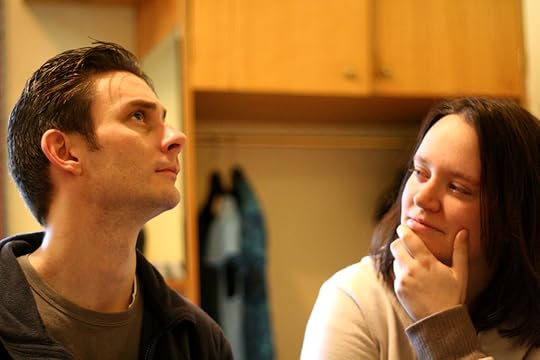
Photo Credit: Sholybonoly via Compfight cc
One of the questions we discussed was this one—”What does every potential parent need to know?”
We quickly filled the white board. But, we understand that it’s kind of like married couples putting together a list of what engaged couples need to know about marriage. It’s hard for us to hear good, sound advice when we are in the courting phase of a relationship.
But just maybe you are different as you consider making this monumental commitment to a child or more that most definitely come from a hard place.
Here are some of the things this group came up with to pass on to you:
Prepare your family for a drastic life-style change. If you are used to traveling twice a year out of state for vacation, you might need to postpone these for a few years. If you and your spouse work 60 plus hours a week, that might need to change. In other words, if you try to keep doing life the way you did before you foster or adopt, you most likely will face big challenges. Danielle and I were used to going on at least one mission trip per year before we began fostering and then adopted. We put that on hold for a couple of years before we each went on a trip. Even now, five years into our foster/adoption journey, we have decided that we need postpone that part of our lifestyle for a bit longer.
Look for ongoing support. Please don’t try to do this alone. Before accepting that first foster placement or bringing home your adopted child, put a team of support together. This will include family, friends, and professionals.
Know that resources are available. This dovetails off looking for ongoing support. All kinds of support is available, such as, ongoing training, online videos and articles, books, support groups, conferences, counselors, doctors, etc. You also need to know that you probably will have to use a different set of doctors than what you use with your biological children.
Make sure your whole family is in. You would be surprised how many jump into this commitment when even the husband and wife aren’t on the same page. Just as important is that your children are all in on the idea as well. This commitment might have the most impact on their lives.
Understand the child(ren). Like any child, these children are unique and have different needs. As the parent, you need to engage that child, learning as much as you can about who they are and where they come from. Learn what Trauma Care is and how to connect and empower your child while you correct them.
Remember that healing is ongoing. It is tempting to assess your child’s needs and come up with a timeline for when your child will be declared healed from their past. A better approach will be to expect different challenges to surface as your child ages. Another reason to have adequate support and resources in place.
Learn about Trauma Care. Even if you held your adopted baby in the delivery room, odds are he experienced some trauma. If your child suffered abuse, neglect or many other risk factors from time spent in foster care or institutional care, they no doubt experienced trauma. Learning how trauma effects brain chemistry and behavior will help you know how to connect, empower and correct your child.
For more information here are some Steps to Foster or Adopt.
Want to add some more things that a potential foster or adoptive parent should know? Please share in the comments below.



